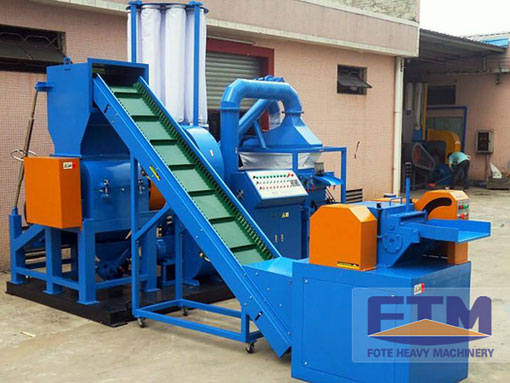Screening is mainly used to enhance the recovery of metal; some chopping lines also use screening to get the desired chop size. The smaller the size of granule, the more efficient the removal of metal is.Similar-size granulators that collect on the screen are then discharged and fed to an air table that is slanted in two directions. After this process, we can get clean metal product and essentially metal-free tailings.If you need other guide, please visit Fote Heavy Machinery, a top manufacturer of copper cable granulator and cable recycling machine.
 If you
have such copper wire
recycling machine, you will have extra profit, that is to say, selling the
“floats” and “sinks” to others who carry out the moulding and market the moulded
products. This way has been underway in many countries and regions such as
Japan, Europe and America. A lot of products are made from such material such as
traffic sign bases, speed bumps and parking bumps.In this plant, cable scrap
needs to undergo two granulating process.
If you
have such copper wire
recycling machine, you will have extra profit, that is to say, selling the
“floats” and “sinks” to others who carry out the moulding and market the moulded
products. This way has been underway in many countries and regions such as
Japan, Europe and America. A lot of products are made from such material such as
traffic sign bases, speed bumps and parking bumps.In this plant, cable scrap
needs to undergo two granulating process.
In the primary granulator,copper recycling machine stripping of the insulator and jacketing is only partially achieved, which the cable chops are typically about 7-8 cm while the maximum length of granule produced by the secondary granulator is about 0.6 cm. Such fine granulating usually liberates most of the insulation from the cable but inevitably small amounts of metal left in the plastics.
Hydrogravimetric processing, also named sink and float processing, is to use a sink/float tank with water to isolate a clean polyethylene (specific gravity less than 1.0) that floats and PVC fraction (specific gravity greater than 1.0) that sinks.The material that floats can be used for the injection moulding of such products as flowers pots, while the “sinks” are used for injection moulded floor mats, etc.
| 리버풀 이야기 축구 이야기 자유 게시판 포토 갤러리 축구 동영상 잘 부탁드립니다 | 최근 댓글 |
